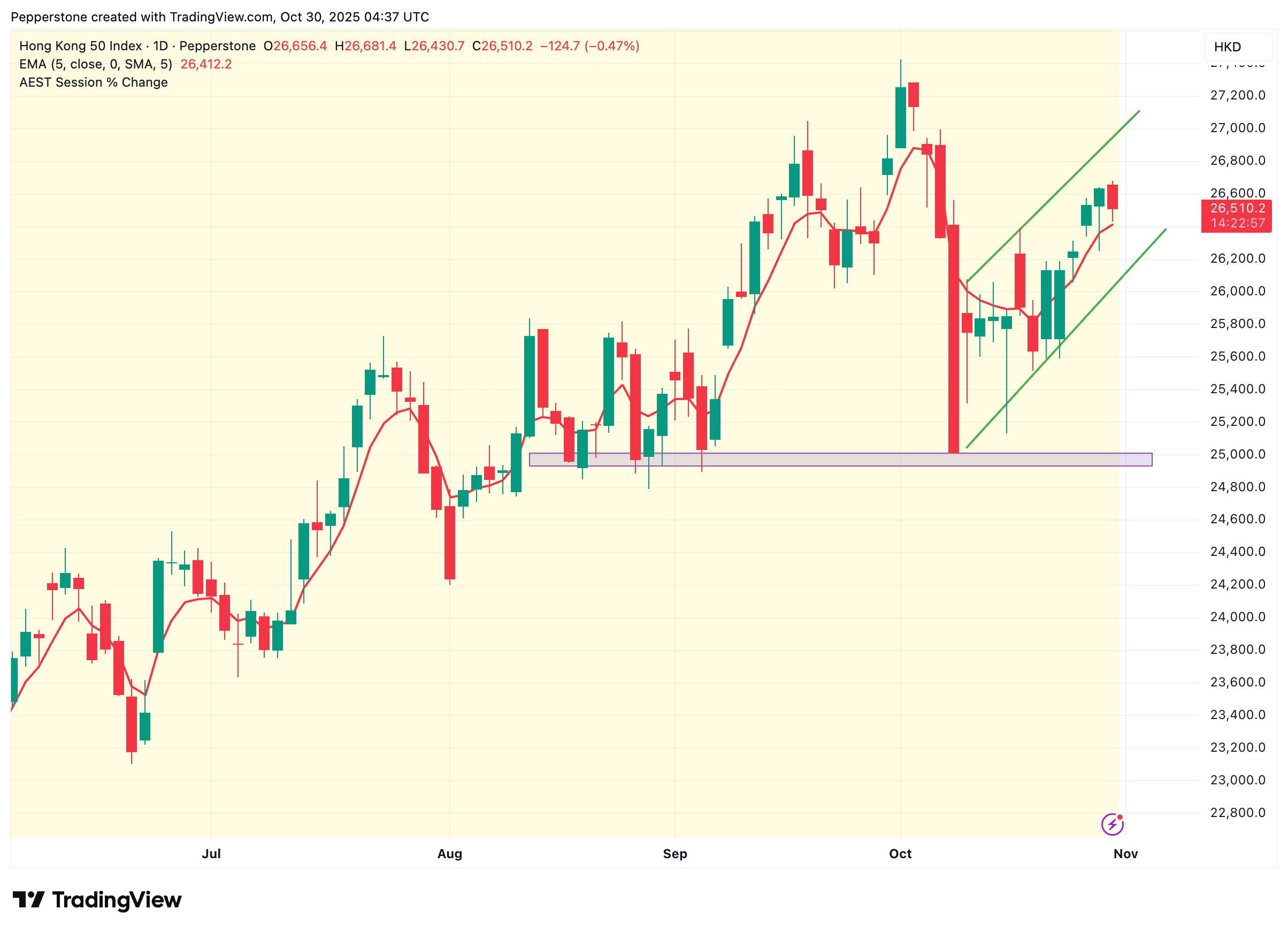- English
- عربي
Hong Kong Stocks Rebound: Fed Rate Cut + US-China Talks Support Hang Seng Recovery
.jpg)
Following a sharp pullback in early October, the Hang Seng Index has resumed its upward trajectory, supported by a global liquidity rebound and tech sector leadership. As expected, the Federal Reserve cut interest rates by 25bp, with the Hong Kong Monetary Authority following suit, injecting fresh liquidity into the market.
Meanwhile, US and Chinese leaders met at the APEC summit, raising traders’ expectations of positive progress in trade talks and significantly improving risk sentiment.

With multiple tailwinds in play, Hong Kong stocks opened broadly higher, led by tech, resources, and financials. Large-cap internet and AI-related stocks rebounded, while base metals surged on tight supply and long-term demand expectations. Banks and insurers also performed steadily, supported by improving earnings and interest rate outlooks.
Tech & AI: The Revaluation Frontier
Tech stocks remain the key driver of this rebound. Nvidia’s market capitalization surpassing $5 trillion has reignited enthusiasm around AI, pushing global tech valuations higher.
Leading Hong Kong tech names linked to AI, cloud computing, and hardware benefited strongly: JD.com, Bilibili, and Kuaishou all gained over 2%, while Tencent, Alibaba, and Meituan strengthened. Apple supply chain stocks such as FIT Hon Teng also attracted attention amid strong iPhone 17 sales in China and potential hardware upgrades.
Traders should note two cautions. First, Nvidia and US tech earnings may amplify short-term volatility in Hong Kong tech shares, but fundamental support will only be validated as earnings are reported in mid-November.
Second, while macro conditions are improving, end-demand recovery remains incomplete, and lower financing costs will take time to translate into profits. Growth stocks with limited earnings visibility or weak valuation support could face pressure as markets shift from sentiment-driven to fundamentals-driven trading.
Under this backdrop, traders may focus on short-term opportunities in tech leaders with visible earnings, healthy cash flow, sustained R&D, and reasonable valuations. These names are better positioned to provide “steady growth” support amid improving policy and global liquidity. Conversely, high-volatility or cyclical profit stocks should be approached cautiously to avoid chasing sentiment-driven spikes.
Resources & Financials: Dual Support from Fundamentals and Capital
Beyond tech, resources and financials also stood out in this rally.
Copper prices surged to record highs amid supply disruption concerns, lifting stocks like Jiangxi Copper and Aluminum Corporation of China. Over a longer horizon, demand for copper from new energy, storage, and electric vehicles remains robust. Combined with a global easing cycle, commodities continue to benefit from both inflation-hedging and cyclical recovery logic.
This provides additional support to the Hang Seng, particularly for resources and materials, as abundant liquidity reinforces the sustainability of profit recovery.
Financials also demonstrated resilience. HSBC’s share price jumped over 4% post-earnings on October 29, leading banking gains. Third-quarter net interest income grew nearly 15% YoY, highlighting strong balance sheet management amid falling rates. Lower global financing costs should support Hong Kong credit activity, easing pressure on banking margins.
Meanwhile, major banks like Hang Seng Bank and Bank of China (Hong Kong) remain attractive for “high dividend + low valuation” allocations due to solid capital buffers. Insurers such as AIA also showed marginal recovery with a stabilized yield curve and improved investment returns.
Overall, the financial sector provides steady support to the Hang Seng, acting as a shock absorber during market swings.
Hang Seng Likely to Maintain Short-Term Strength; US-China Talks in Focus
Overall, with support from tech, resources, and financials, Hong Kong stocks are expected to maintain a short-term upward bias. Rate cuts and expectations of easing US-China relations are driving funds back into risk assets.
In the near term, if the US eases tariffs or signals goodwill in trade talks, tech and export-oriented sectors stand to benefit directly, reducing market risk aversion. Conversely, a stalemate or new frictions could weigh on the Hang Seng.
Recent US statements on supply chains and investment restrictions suggest a more pragmatic stance, fueling expectations of partial easing. For the Hang Seng, this could mean lower volatility and potential upward adjustment of valuation midpoints.
Over the medium term, Hong Kong valuations remain well below major global markets. Stable yuan, improved domestic consumption, and stronger manufacturing data could further attract overseas capital, leaving room for structural gains.
The material provided here has not been prepared in accordance with legal requirements designed to promote the independence of investment research and as such is considered to be a marketing communication. Whilst it is not subject to any prohibition on dealing ahead of the dissemination of investment research we will not seek to take any advantage before providing it to our clients.
Pepperstone doesn’t represent that the material provided here is accurate, current or complete, and therefore shouldn’t be relied upon as such. The information, whether from a third party or not, isn’t to be considered as a recommendation; or an offer to buy or sell; or the solicitation of an offer to buy or sell any security, financial product or instrument; or to participate in any particular trading strategy. It does not take into account readers’ financial situation or investment objectives. We advise any readers of this content to seek their own advice. Without the approval of Pepperstone, reproduction or redistribution of this information isn’t permitted.